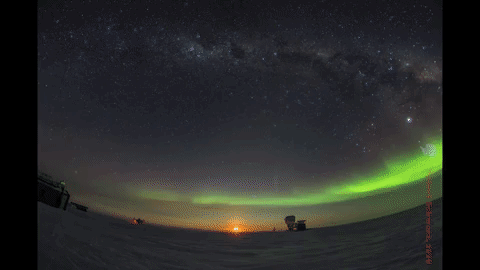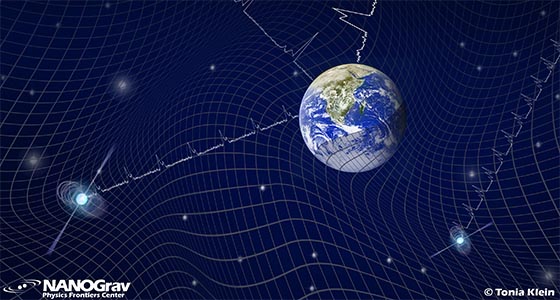On the Pulse of Pulsars and Polar Light
Reimagined telescopes may fill the void left by Arecibo’s collapse
Press conference: 12:00 p.m. CDT, Saturday, April 17, 2021

The night sky dances with auroras over Dark Sector Laboratory at the Amundsen-Scott South Pole Station at the geographic South Pole. On the very far right, inside the silver ground shield, is BICEP3, which has been observing since 2016. The BICEP/Keck collaboration operates a series of small aperture telescopes including BICEP3 that are targeted at the search for signatures of inflationary gravitational waves. Credit: Robert Schwarz
Faced with the tragic loss of the Arecibo observatory in Puerto Rico and the often prohibitive cost of satellite missions, astronomers are searching for savvy alternatives to continue answering fundamental questions in physics.
At a press conference during the 2021 APS April Meeting, they will reveal new tactics across both hemispheres for illuminating gravitational waves and dark matter.
Shining the oldest light in the universe on dark matter
At the South Pole, a powerful set of telescopes could add a new function: studying the nature of dark matter and the history of stars.
Only satellites can carry out surveys of the full sky, while Earth-based telescopes are able to spend years accumulating a lot of data on small patches. The BICEP/Keck array was designed as the world’s most sensitive detector of the polarization of medium-to-large sky features. From Antarctica, the array searches small areas of the Big Bang’s afterglow for primordial gravitational waves.
Cyndia Yu, a graduate student at Stanford University, and the BICEP/Keck team are exploring the possibility that the very same telescopes could increase the length of their scans—and thus capture much larger areas.
“We are appreciating more and more the promise of moving away from detecting extremely faint signals on a small area, to looking for features on a larger sky patch,” said Yu.
The unconventional approach has yielded promising early results. Yu will share the initial performance of trial scans and forecast how sensitive the telescopes will be to targets including axion-like dark matter candidates and WIMP annihilations.
“Satellite missions are very rare and expensive, so any chance we get to make more measurements from ground-based programs is very exciting,” she said.

Representative illustration of the Earth embedded in space-time (which is deformed by the background gravitational waves) and its effects on radio signals coming from observed pulsars. Credit: Tonia Klein / NANOGrav
Catching the wake of supermassive black holes
In the northern hemisphere, galaxy-sized detectors are hunting for gravitational waves of very low frequency from the largest black holes in the universe.
“In some ways, these arrays are like the LIGO detector,” said Megan DeCesar, Senior Research Scientist at George Mason University, referring to the observatory that first detected gravitational waves from other types of smaller black holes.
“While LIGO uses lasers on Earth, pulsar timing arrays use steady pulses of radio waves from small, dense, rapidly rotating stars called pulsars that are located thousands of light years from Earth,” she said.
DeCesar and the North American Nanohertz Observatory for Gravitational Waves collaboration analyzed more than a dozen years of pulsar data.
They recently reported a signal that may be the first hint of a gravitational wave background, and which was stronger than expected based on previous data. If confirmed to be a gravitational wave signal, it would mean the discovery of gravitational waves produced from many double-black-hole systems, each of which will eventually merge to form even larger single black holes.
Arecibo played a crucial role in NANOGrav observations. Its collapse in December dealt a blow to the collaboration, but thanks to increased observations at Green Bank and other facilities, NANOGrav is still on track to detect gravitational waves with several more years of data. DeCesar will discuss how current telescopes in West Virginia, New Mexico, and British Columbia, and future sensitive radio arrays, will allow NANOGrav to meet its gravitational-wave science goals.
FEATURED TALKS
CMB E-mode Science With the BICEP/Keck Program (S09.8)
2:54 p.m. - 3:06 p.m. CDT, Monday, April 19, 2021
Cyndia Yu, cyndiayu@stanford.edu
Livestream: Access here
Abstract: http://meetings.aps.org/Meeting/APR21/Session/S09.8
The Search for Gravitational Waves With the NANOGrav Pulsar Timing Array (B01.1)
10:45 a.m. - 11:21 a.m. CDT, Saturday, April 17, 2021
Megan DeCesar, megan.decesar@nanograv.org
Livestream: Access here
Abstract: http://meetings.aps.org/Meeting/APR21/Session/B01.1
PRESS CONFERENCE
Register for the press conference, to be held on Zoom at 12:00 p.m. CDT, Saturday, April 17, 2021.
Speakers:
- Cyndia Yu (Stanford)
- Megan DeCesar (George Mason)
Press Conference Schedule
Register for each press conference separately at the links below. Press conferences will be recorded and made available upon request.
Saturday, April 17
10:00 a.m. CDT Measuring Neutron Star Squeezability
NICER collaboration, NASA astronaut reveal size of most massive neutron star, highlight Space Station science
Register
12:00 p.m. CDT On the Pulse of Pulsars and Polar Light
Reimagined telescopes may fill the void left by Arecibo’s collapse
Register
Sunday, April 18
10:00 a.m. CDT The Future of Particle Accelerators Is Here
Behind the scenes of the Electron-Ion Collider, green accelerators that waste no energy, and chiral magnetic effect results debuting this summer
Register
12:00 p.m. CDT Scientists May Detect Signs of Extraterrestrial Life in the Next 5 to 10 Years
Telescope launching this autumn could spot biosignatures on other planets within three days
Register
Monday, April 19
11:00 a.m. CDT The Fate of the Planet
Unconventional takes on pandemics and nuclear defense could protect humanity from catastrophic failure
Register
